Review of the market for decorative radiators: modern design development, instrument types, options for using devices in the interior.
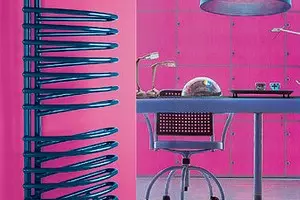
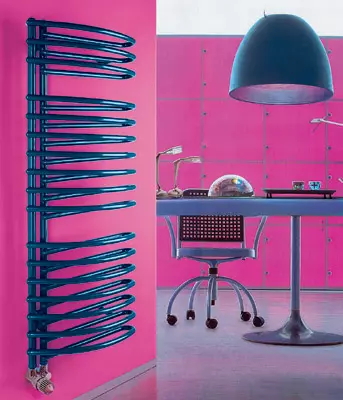
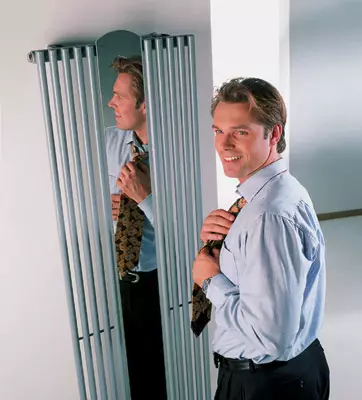
Fortunately, those times passed when the design radiator in the domestic interior was rare. Now on the market you can find everything that your own, for example, a tubular radiator framing a mirror. Such a device is able to decorate any entrance hall.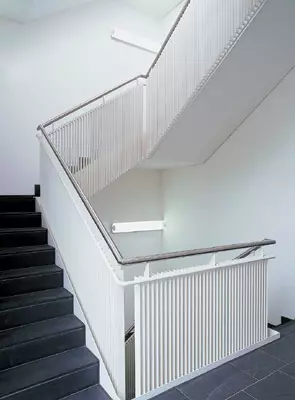
The radiator-balustrade is simultaneously a fence and heater of the staircase. You can install such a model not only in the new, but also in the long house built, and without laying supply pipes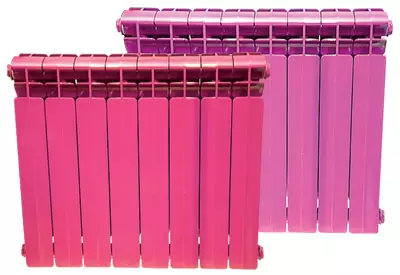
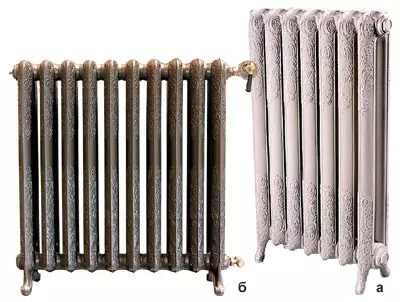
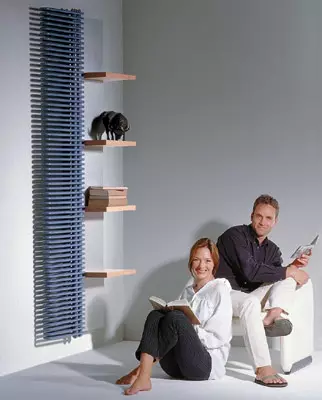
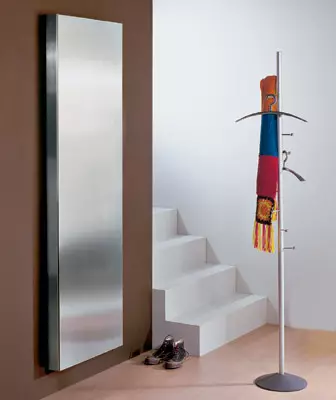
The panel radiator with a flat, almost mirrored front surface will not only decorate the interior of the hallway, but also dries wet clothes, hanging in front of him on a rack hanger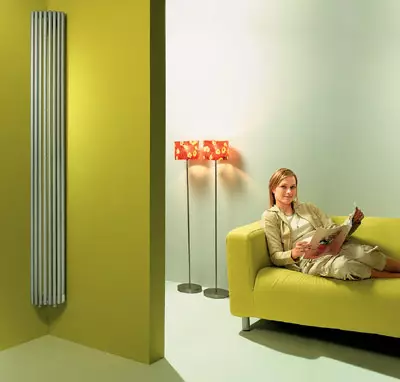
Semicircular model of a tubular radiator for installation in the corner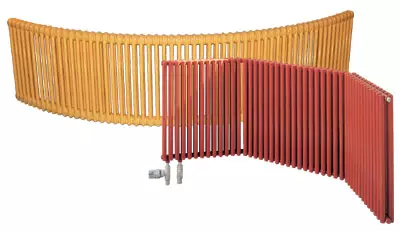
Tubular radiators can be bend both by radius and at an angle, in accordance with the surface form, which they will "contend"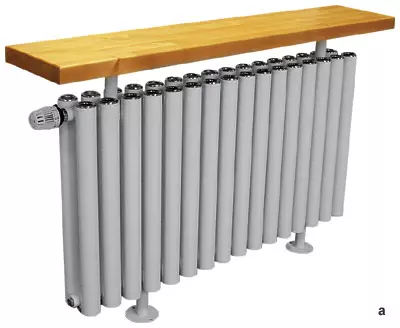
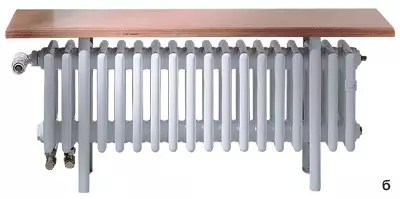
"Stoves-shop" based on radiator convector (a) and tubular radiator (b)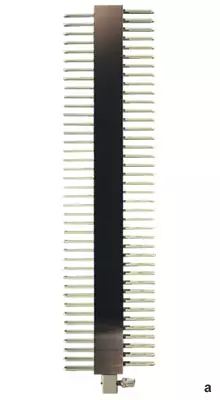
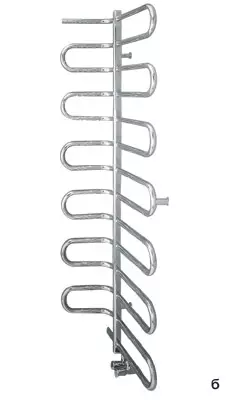
Design radiators intended for installation on a flat (a) surface and in the corner (angle internal) (b)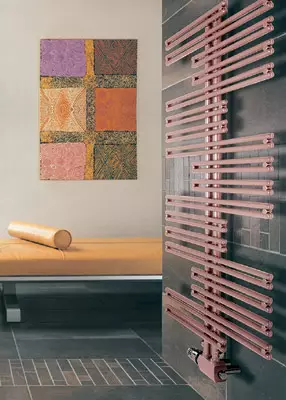
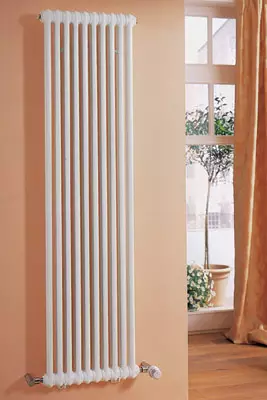
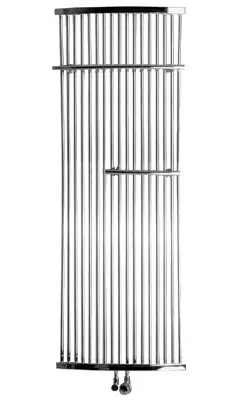
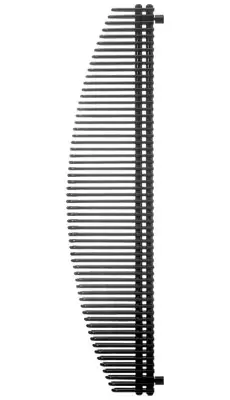
Translucent screen or partitions can be successfully replaced by similar radiators, which in this case are perceived as elements of architecture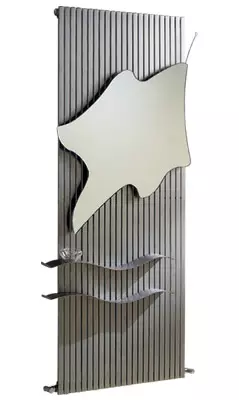
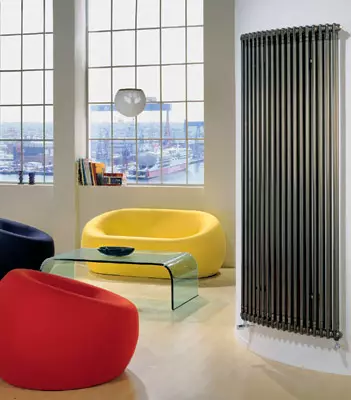
An example illustrating the role of the radiator in the modern interior. Tubular design in the living room is perceived as a temporary and even necessary decor element.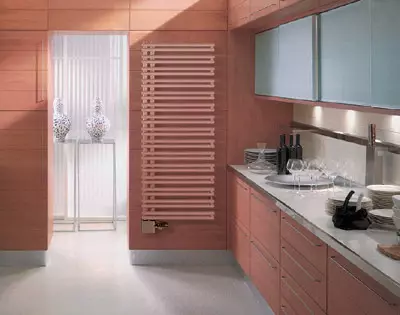
Application in the construction of new hermetic windows and energy-saving technologies allows you to place a radiator not at its usual place - under the windowsill, but in accordance with the requirements of the interior stylist and the architecture of the room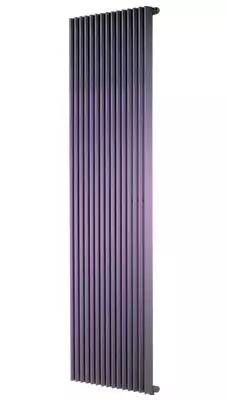
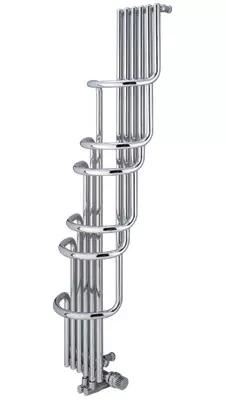
Traditional tubular radiator Designers forced to turn into an art object
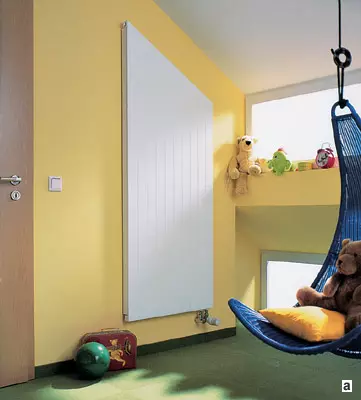
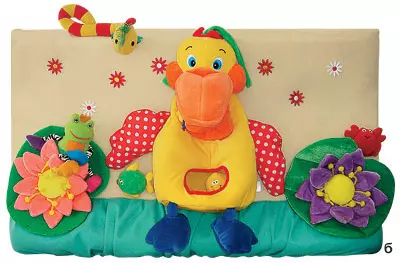
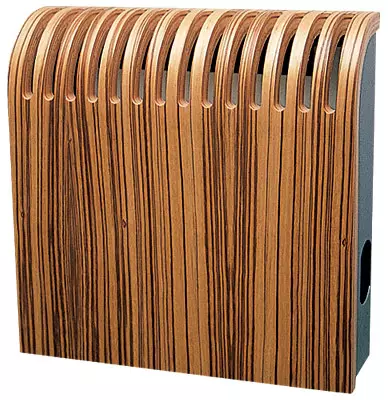
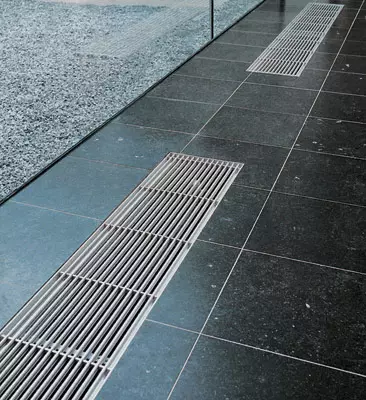
Built-in floor, simpleness, niche or furniture convectors become "invisible" in the interior
A modern radiator long ago ceased to be only "ribbed and warm." It is functional, convenient for mounting and beautiful. No one else will come to hide this stylish thing behind the core or decorative screen. On the contrary, designers often put it on the most prominent place in the interior: a decent center of the composition!
Design and radiator
At the beginning of the twentieth century Designers have already explained to the whole world that any functional object can and should be beautiful, and beautiful, in turn, functional. It was then, at the dawn of the new industrial era, a narrow-professional term "Design-Radiator" - "Design Radiator" arose. In fact, it would be more correct to translate this expression as a "decorative radiator", but ... fashionable and today the word "design", perhaps, accommodates much more than the old-fashioned "decor".Skeptics will notice that only in the conditions of a soft European climate on the heating device can be unselfishly admired, and our harsh reality makes thinking about the urgent problems associated with the inexorable laws of thermophysics. One Russian engineer noted: "The heat transfer must be excellent, and the external species is the tenth." We cannot agree with this statement. Winteriere, as in a person, everything should be fine, even the radiator.
You do not need, and nam - fusion!
It turned into a habit of scolding old cast iron radiators "accordions", which, by the way, faithfully served us for decades. However, think: in new homes you are unlikely to meet a similar "rarity". Therefore, if you even accepted a solid solution to get rid of the old, miraculously the surviving "accordion", let your hand with a detachment key will stop for a few seconds. During this time, you have time to figure out that for the interior in the style of fusion (mixing various, sometimes contradictive design directions), or country, or even High Tech more stylish and with an absolutely "reliable" accessory not found. First of all, check the safety of your "raritet". If he is not "thrust" from the inside rust and scream- consider what you're lucky and boldly try to work. Remove with powerful "ribs" multi-layer and really unaesthetic oil paint glands (special hairdryer or washes), pass through them with a skin and cover the thin layer of the heat-resistant paint or varnish "under rzavchin". This will be real, will not be afraid of this word, Vintage! That is, really old, laughed, a lot of seeking and therefore a particularly beloved and appreciated thing.
From tradition - to avant-garde
Of course, not everyone is so tied to the past to die in the form of a rusty "harmonica". But why definitely rusty? Roca (Spain) and Demir DCM (Turkey) skillfully used the mood of retro, widespread now around the world, and offered a series of artistic retroradiators decorated with a relief pattern (made in artistic casting technique). The cost of Spanish products - from 80 per section, Turkish - from 40. Note that for the classic interior of the best option is not found.
Not only the decor mentioned above, but also the progressive evolution of the form is perfectly traced on the example of cast-iron radiators from Viardus (Czech Republic), demonstrated at the ISH exhibition in this year in Frankfurt am Main. The Gussradiator model (translated from the German-"cast radiator") with sections having a trapezoidal configuration will be relevant both in the traditional and in a completely avant-garde interior.
Companies that do not produce cast iron radiators, also bring a lot of new things in the design design of their products. Thus, Sira (Italy) produces bimetallic RS radiators, in which not only the form is changed (it is supplied so urgent in modern design "aerodynamic" roundness), but also a design. Here are completely hidden internal vertical ribs, the most, which usually collect dust and dirt and are not available to a brush or a sponge. ATA, Agree, not only improves appearance, but also simplifies the care of the heating device.
The domestic firm of KZTO has remembered steel convectors, at one time there are no accidents called "crocodiles". Elementary designer improvement, demonstrated in the "effect" series (instead of bent cut from the steel sheet "Scales", short segments of a two-link pipe are used), turns imaginary retro in the most real avant-garde. Another advantage of this model is small dimensions: height - 200mm, depth of the single-row design - 51mm, double-row- 117mm, length - from 290 to 1776mm. Price, 12-80.
By the way, not only the form, but also the color of the radiators is "visible". Radiators, painted in all colors of the rainbow, offer the Croatian firm Lipovica, Austrian Olympia and Vogel Noot, the Italian Faral plant (enters the concern Zehnder Group, Switzerland).
Do not forget that you can pick up a color for finishing at your own discretion and ask any manufacturer to take it as your individual order. It is usually performed from two to four weeks, such a model will cost 15-30% more expensive than serial.
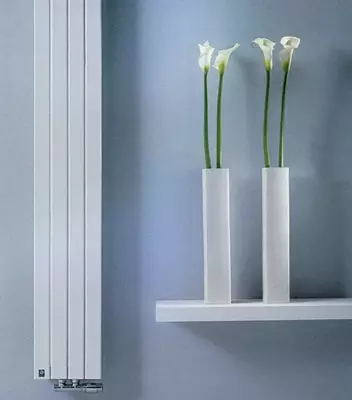
Radiator made of flat pipes, looks like a decorative wall panel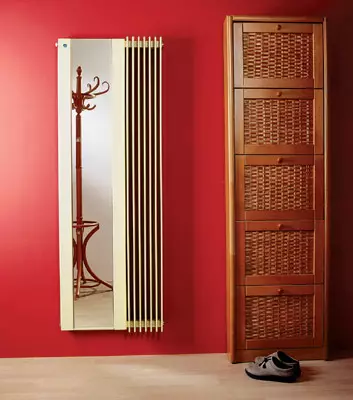
A similar radiator, equipped with a mirror, can be positioned next to the entrance door in the hallway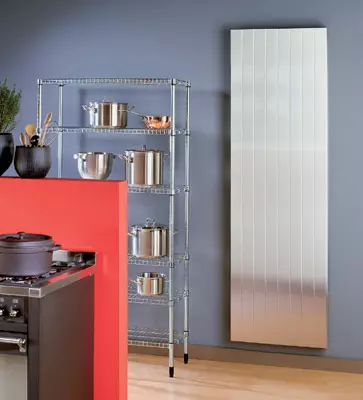
Design radiators can be installed in the hallway, residential rooms, in the kitchen
Original design
The famous phrase "shape follows the function" is fully applicable to the design of radiators. This is followed by the example of two types of heating instrument and panel and tubular. Note that both are widespread due to the rich selection of sizes, from small to huge. This allows you to use both types of radiators in unusual quality.
Panel radiators They are metallic (steel, less often copper or aluminum) box with fins on the back side. Initially, they were created for the modern interior, emphasized the functional and deprived of any decor. Traditional radiators in such cases not to disturb stylistic unity, sometimes close flat and monochrome (usually in tone walls) screen. Panel models fit perfectly into minimalist entourage without disguise. Laconism and some "architecturality" of their appearance suggest designers unusual decorative solutions. For example, high vertical panels are placed symmetrically on both sides of the door (windows, mirrors), as a result of which they are perceived as peculiar pilasters. Long models are also used. Panoramic glazing from the ceiling to a favorite reception of modern architects does not allow the use of radiators of the usual height. Low and long modules installed on the perimeter of the room (which, by the way, can have complex outlines), do not violate the "transparency" of penthouses and lofts and at the same time provide a sufficient amount of heat.
Not so long ago, Zehnder, Kermi (Germany), Vogel Noot (Austria), Thermic (Belgium) IDR. They began to produce models with a flat and absolutely smooth front surface (an additional flat panel is fixed on the front "finned" side), which is painted in different colors. This is no longer quite minimalism, because shades are the most bright. In addition, the panel can be painted with heat-resistant paints (we recommend inviting a professional artist for these purposes) and result in a thing in the spirit of so fashionable pop design or kitsch.
Steel tubular radiators . Their body is formed from steel tubes. The stamp point of view these radiators are quite competitive, they have a small internal volume and low thermal inertia. Awet from the point of view of aesthetics is a real gift to lovers of constructivism and High Tech style.
Round pipes . Let's start with the fact that the high strength of the resulting design allows the radiators to be made up to 6m and almost unlimited lengths (the widest range of such models is offered, for example, the German companies Arbonia and Zehnder). Another purely design dignity of tubular models - they can be given almost any configuration, including curved (the minimum bending radius of each series of radiators). A results from the tubular sections connected to each other can be obtained by direct and wave "screen", high "columns" (tubes located nearly close, form a relief, similar to relief flutes of real columns) and even fencing staircases and all sorts of podiums or framing bar racks . Curved models Easily enter into erkers or semicircular niche in a word, everywhere, where it is necessary to follow the non-standard configuration of walls or partitions. Punching Original balustrade can be used specifically for this designed products of Jaga products (Belgium, VIDE series) and Zehnder (Excelsior Series).
Curved tubular radiators make mainly to order, the period of execution of which ranges from two weeks to one and a half months. The price is about 50% higher than that of flat models.
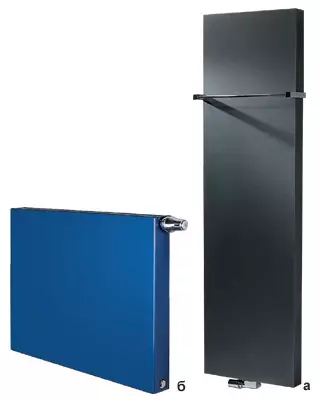
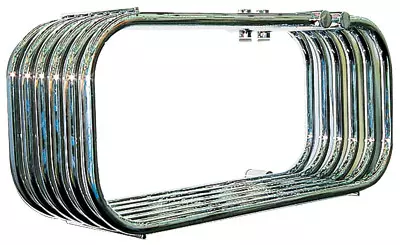
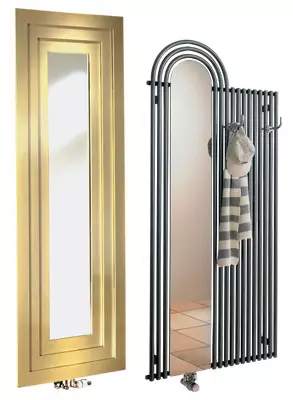
Radiators with a mirror for the hallway from Arbonia
All the pipes can be not only traditionally round. Manufacturers such as Arbonia, Zehnder, Jaga, Vasco (Belgium), Cordivari (Italy) IDR. Used Flat rectangular pipes . There are different schemes for their location relative to collectors. Models with flat pipes, welded to the collector with a wide side close to each other or a rotary. Externally, they differ little from panel radiators. Hence the completely logical desire of decorators designers to use their smooth and flat surface "by appointment."
The first thing that comes to the head is fashionable "prints", which still recently, artists with approval decorated increasingly or less suitable free areas (from jeans and pastes to kitchen furniture facades). So, the company Cordivari offers to "reprint" on the radiator drawing, made by your child, or his photo. Teenagers from such "chips" come in full delight. Moreover, the flat tubes break the drawing into separate strips, make it as if fractional, "computer" and from this even more attractive for the present braid. Such work is performed, of course, exclusively by individual order. To do this, it is enough to provide masters a photo image in electronic form or slide, and they will transfer it to the radiator within a few days.
Flat pipes welded to the collector with a narrow side of the error, look rather concisely and strictly. No additional decor is needed, since the front side is already looking as a grid screen and the interior in the style of High Tech is perfect.
Triangular pipes Also used by manufacturers wide enough. It is extremely interesting to design, for example, a series of iGuana's design radiators from Jaga. If you look at the model from above, the triangular tubes turn into the rays, as if emanating from the collector. This can be said, the symbolic image of the Sun as a source of heat, performed without any decorative additions, is expressive in itself. Radiators series can be different in size and configuration: round freestanding or closing metal columns, flat wall, deposited, semicircular and intended for angular installation.
"Art objects" . According to the design to tubular radiators, model should be attributed, externally more resembling an abstractionist sculpture. Nickel plated pipes are not tied only: they give the shape of the letters of the Latin alphabet, musical signs, colors of IT.P. For example, the "letter" graphics is presented in the ETREETERM collection from ArbOnia, and the Kitchen Radiator Paris from Vogel Noot looks like a frozen waterfall, brilliant "jets" which are made of nickel-plated tubes. Sometimes such radiators are offered with a decoration of ... Sustal Gold (Zehnder, Vogel Noot), but also they are, naturally, 2-3 times more expensive than ordinary.
Rectangular tubes welded to the collector at an angle. Externally, such models extremely resemble horizontal blinds with inclined slats. By the way, this similarity can be beaten in the interior, combining radiators with real blinds. Especially since it is possible to paint the panels (to order) in any shades on the RAL system. With such an unusual design of the type of radiators in question between the pipes, inclined slits are formed, which contribute to the creation of a strong convective air flow - from here and increased heat transfer. The example of the Deco Louvre series radiators from Jaga can be brought.
The convective stream is so strong that these devices can be attributed to the new type of radiators-convectors. In a complex embodiment, such a device consists of two rows tightly pressed to each other flat pipes (welded parallel to the collector), in the space between which the convective flow of air rises. This design is implemented in Zehnder Radiators (NOVA Series), Vogel Noot, Jaga (Panel Plus series) and some others.
The Russian firm KZTO has embodied in its radiators-convectors "Harmony" and "Stella" a different solution. The basis of their design is the hollow vertical pipe. The main design dignity of these models is a visual ease, which many other radiators are unfortunately deprived. Different interior, a similar tubular design, reminiscent of the mini-organ, can be set anywhere, and no screen will be needed.
The coolant, moving inside the pipe, heats both the outer and the inner walls, which causes the occurrence of a convective flow of air in the inner space of the hollow tube. The manufacturer carries out its products to also decorative rims, chrome-plated or coated "under gold". The Stella model is designed for both ordinary and too high rooms, where other radiators are mounted in several tiers. Modeled for the hallway in the kit can be offered a mirror. The idea of using a hollow pipe is also implemented in the products of the SETA series from Bisque Radiators (United Kingdom).
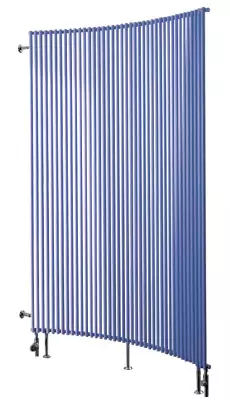
The curved arc tubular radiator can be used as a screen, partition. Similar method of zoning space is widely used in modern design.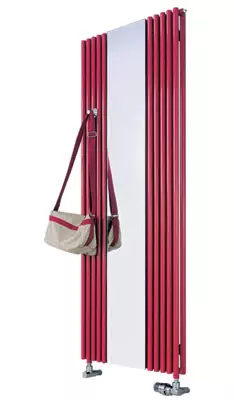
In this case, before us, the "four in one" model: radiator, mirror, shelf and hanger. Note that such an almost universal set is not yet limited to the flight of designer fantasy.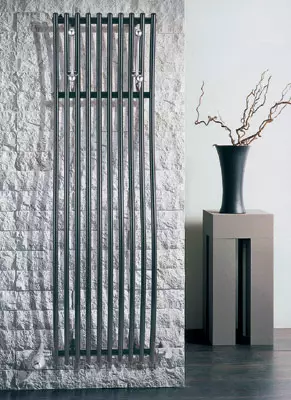
Opening a tubular radiator with special hooks, you can create a beautiful hanger dryer for wet clothes. Wonderful solution for our climate
Strong behind the bars!
Long ago, when domestic heating devices did not please anyone with their exclusive design, there was an opinion among the architects that a good radiator is an "invisible" radiator. Those legendary times, fortunately, have passed, but now the radiator does not always find himself in the interior of the "welcome guest". For example, Country style implies a stove or fireplace rather than "urban" style and the spirit of the panel and tube. In case of a huge service, the designer can have built-in convectors. Usually they are hiding from prying eyes in special recesses in the floor, niches in the wall and even in the furniture. The device of such models is sufficient simply: the heating element on a special stand and a metal box, closed with a decorative lattice. It only remains in sight of the entire design (the rest - in niche), so this decorative element is made from the profile aluminum rods painted in different colors of the valuable wood species.
In our market, such models are offered by Jaga (MINI CANAL and CANAL PLUS series), MOHLENHOFF (Germany, SK and GSK) IDR. Cost: embedded in floor-280-5000, depending on the size (length, 1-5m), materials and lattice design.
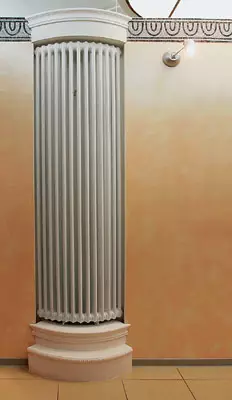
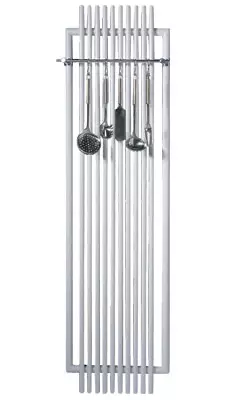
In the kitchen, the radiator can be used as hangers - dryer dryers for kitchen utensils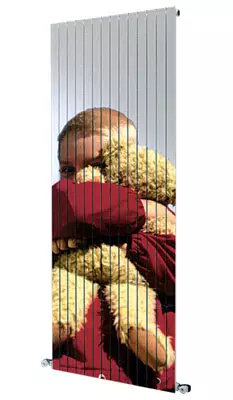
The radiator with a photo of your child will be the highlight of the interior of the children's
Radiator in the new amplua
Beauty and functionality, repeat, things are quite compatible. That is why designers quickly came to the idea that the "free space" of the radiator can not only decorate, but also somehow practically use.
We will risk assumed that the first designer or engineer, guessing to make a bench, school teachers were often criticized for a habit of sitting on a heating device. First, not aesthetically, secondly, hotly, and even "ribs" are imparted. Well, of course, you need a seat! Now in the Russian market, such "stoves-shops" offer several companies at once: Zehnder, Arbonia, Jaga and KZTO.
The basis of the ingenious design is the heating devices of different types: tubular radiators with horizontal sections arrangement (model Bank Radiator from Zehnder - from 650, a similar model offers Arbonia), with a vertical section of sections ("Zavalka" from KZTO, Charleston Relax and Charleston Bank from Zehnder ). There are models and based on convectors, such as Bank RadiaVektor from Zehnder and Panel Plus Bench from Jaga. The seat itself, as a rule, make a natural tree.
It is necessary to explain that such a cozy "stove-shop" can be used in any area of the interior: in the bathroom (here it is not recommended to sit at the cold at all), in the erkers and on the verandahs (everything is cold, and you are warm and nonsense), In the gym, winter gardens IT.P. Especially for premises with high humidity, some manufacturers, such as Zehnder, are produced galvanized radiators-shops.
It is clear that the lavet was not limited to the shop. High panel and tubular radiators can be used as hangers. The device is element: hooks for clothes are fixed on the front panel. Percehable on them grooved raincoat and scarf, and in an hour they hang in the same place, but already dry and charming warm. A logical continuation of the idea will be fixed on such a radiator also a mirror with shelves for accessories. For example, in the Rondotherm model from Arbonia, the mirror opens like a door, and you can hide a plumbing niche, distribution switch, electric meter, and other not too attractive, but necessary "economic trivia".
It is from that that the heating device can perform the screenshots and even partitions, we have already spoken. But the radiator in the role of a decorative screen for the bath is already something special. This model offers Jaga. Special heat exchangers, steel perforated screens and angular elements are installed with one or even three sides of the bath, forming a decorative screen. A result of warm air not only heats the room, but also supports the constant water temperature. The cost of recruitment is 386-485.
Interesting projects presented the Russian company "Isotherm" together with the designer Victoria Malysheva. Instead of the traditional front panel of the convector, we see ... the facade of the chest with drawers and brass handles. For children, a special panel is designed, consisting of a textile base and soft toys fixed on it using the "Velcro" fastener. The child will not hit, will not be burned and will be quite satisfied with such a cheerful heating device.
These and other equally original things indicate a new, not only the service role of the radiator in the interior. Stylish, beautiful, and even warming in the cold season ...
The editors thanks the company "Time", "Heat-Art", "Termoros", "Interma", "Isotherm", Zehnder, Vogel Noot for help in the preparation of material.
